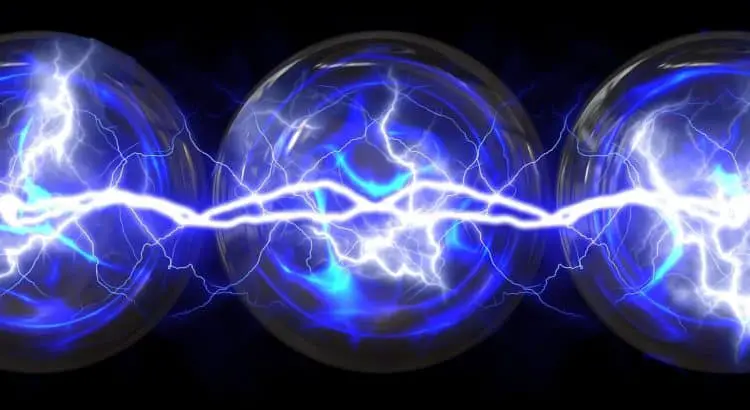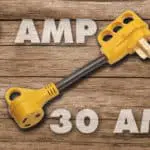The following is a post on RV electricity that was made by a Cool RV Stuff (FB Group) member who is also a journeyman electrician. His posts regarding RV power and electricity were so helpful and well done explaining the basics of RV electricity, we wanted to re-post it here and are doing so with Steven’s permission. Some edits were made for clarity.
I’m a licensed journeyman electrician here. I’m just going to post this to clear up any confusion because reading the comments on certain common social media posts, since there is a lot of misinformation about RV electricty out there. I decided to make a post explaining a couple things that people asked about.
The Basic Concepts of RV Electricity
I am going to try to simplify RV electricity as much as possible. Think of your shore power cable for your RV/Camper as a garden hose and a bucket. Voltage is how much water pressure you have feeding the hose. Watts is how much water you need to fill up the bucket. Resistance is how big the hose is in diameter. Amps are how much water can flow through the hose. The key differences between 30 amp service and 50 amp service are the diameter of the hose is bigger and you have 2 hoses inside that 50amp cable.
Watt RV Electricity?
Watts! So there was confusion and were questions about, “I have a 50 amp trailer and a 30 amp plug. What can I run?” Here’s the deal on this aspect of RV electricity.
Amps aren’t really what determines what you “can” run. The real number is how many watts do you need. To figure out what you can and can’t run you need to know how many watts the thing you want to run needs. In a 30 amp service the limit is around 3,600 watts. To figure this you take the amps (30) times the voltage (120). You get 3600 watts. For a 50 amp it’s the same calculation. 50×120=6000 watts but remember with the 50 amp service you have 2 hoses. 6000×2 is 12,000 watts.
ANY time you use an adapter to connect a 50 amp RV/camper to a 30 amp plug you knock yourself down to 3600 watts. As an example, a 13,500 BTU air conditioning unit (typical on RVs/camper) can use up to 3000 watts at startup and then once it’s fully started up it drops off to around 1300 watts. But a coffee maker can draw 1000 watts or more and that is what’s called a resistive load and will draw 1000 watts the whole time.
These numbers are not exact. Look at the electrical labels on your equipment and add up the wattage stated on the labels for anything you want to run simultaneously. Once you hit 3600 you’re done. I can’t and won’t tell you you can run your AC and a curling iron or really anything specific. Read the labels and know your limits — that’s the best advice I can give on that topic.
What About Converters?
Converters. This is really simple and just needs to be clarified. Converters convert AC (alternating current — household power/pedestal power/regular receptacles etc.) into DC power (anything that runs on batteries in your RV/camper such as lights, water pump, furnace, etc).
The main purpose of a converter is to charge your batteries. People may argue this and I don’t really care. Think of the batteries like a water tank. The converter is the hose filling it with water at a slow pace but you wanna take a shower. You’re going to drain the tank faster than the converter can fill it. You can run some small loads on only a converter but don’t try to run slides in and out or landing gear/leveling jacks without batteries. You may overload the converter and burn it up.
So then What’s an Inverter?
Inverters. These do the opposite of Converters. They invert DC power to AC power. This is what makes it possible to run household items like TVs and coffee makers on battery power. However, going from 12 volts DC to 120 volts AC requires a LOT of amps.
Remember the hose analogy for RV electricity? Voltage is pressure. 120 volts is a lot more pressure than 12 volts so in order to get the same amount of watts out of the end of the hose, you need a hell of a lot bigger hose. That’s why it takes very large diameter and short cables to connect from the battery to inverters that are thousands of watts rated. 120 watts on a 120-volt system only uses 1 amp. 120 watts on a 12-volt system uses 10 amps. When you use an inverter, you’re changing the voltage but the watt requirement is the same. If you really want a good understanding of this, Google ohms law.
Another Helpful Tip About RV Electricity
Multimeters. I am a firm believer in always having a multimeter and testing power before I plug my trailer into any pedestal receptacle. I thought about making a video but Mike Sokol already did and here’s a link to it.
If you’re not confident using a multimeter, get a surge protector that checks power for you. Look at the lights and make sure it indicated power is correct. Always have the breaker off before you plug into shore power. Once your surge protector is plugged into the pedestal but NOT plugged into the camper turn the breaker on. If it shows power is okay, turn the breaker back off, plug in your shore power cable to the surge protector, and then turn the breaker back on.
More On RV Electricty: 50 and 30 amp Basics
RV electricity was a hot topic in the Cool RV Stuff Facebook group so Steven also shared some amazing information about 50 and 30 amp basics which is also shared here with his permission.
RV Electricity Voltage Basics
First of all, 110/120 and 220/240 are voltages. 110 is the same as 120. 220 and 240 also refer to the same voltage supplied. For the sake of this post, I’ll meet you all in the middle and call it 115 and 230. Fair?
Secondly, a 50 amp RV service is fed with 230 volts. There are 4 conductors. Line 1 (115V), Line 2 (115V), Neutral, and Ground. However, there are no RVs that I am aware of that use 230V equipment anywhere in them (see note below).
NOTE: I am not referring to 230V 50hz service as found in other countries. This post’s voltages were intended for North America. I’ve also been informed by a few people in the comments that they have 230-volt equipment. It’s rare but there are some RVs out there that do utilize 230V. They also have protective equipment to ensure that 230V is available to said equipment and if it isn’t that equipment doesn’t work
So essentially, when it comes to RV electricty, you have two 50 amp legs of 115 volts.
A 30 amp RV service is fed with 115 volts. You have 1 Line, 1 Neutral, and 1 Ground.
How RV Electrical Adapters Work
The 50-to-30 amp, or 50-to-20 amp dogbone adapters use one leg of the 50 amp service on one end of the dogbone, and it connects both hot legs together on the adapted side. For example, if you have a 50 amp trailer and you use a dogbone adapter so you can plug into a 30 amp pedestal, the 2 hot leads are separate at the trailer but joined together in the adapter and fed with only the one hot wire from the 30amp receptacle on the pedestal.
This means there are no longer 230 volts to the trailer. Only 115 volts. This is okay since your trailer only uses 115 volts. So don’t run multiple high-load devices on an adapter — such as two ACs at the same time.
This is an example of a 50-to-30 amp dogbone adapter.
Should You Really Be Giving RV Electricity Advice?
PLEASE do not give RV electricity advice to people online unless you are absolutely sure AND have experience in electrical work. There are a lot of electricians in Facebook groups like Cool RV Stuff who will gladly answer your questions.
And if you’re the one posting a question, don’t take the first comments as the correct answers. Generally, you’ll end up with a consensus of people agreeing on the correct answer, and wrong answers should (and often WILL) be pointed out.
Doing your own electrical work can be dangerous and fatal for you and your family if you don’t know what you’re doing and random online RV owners, while mostly knowledgeable, are not always the smartest when it comes to RV electricity.
So RV Electricty Adapters In a Nutshell…
Is a 50Amp trailer 230-Volts? Yes. Does it utilize 230-Volts? No.
Could you use 230-Volt equipment with a 50amp trailer? Technically yes but if you ever use an adapter to a lower amp service and utilize the 230-volt equipment you will burn up the equipment and possibly start a fire. You also don’t know if all campgrounds are using a proper 230-volt system or if the 2 legs are on the same phase. You would have to test power before you plug in with an actual multimeter. Long story short, stick with 115-volt equipment.



